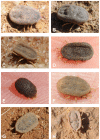The epidemiology and geographic distribution of relapsing fever borreliosis in West and North Africa, with a review of the Ornithodoros erraticus complex (Acari: Ixodida)
- PMID: 24223812
- PMCID: PMC3817255
- DOI: 10.1371/journal.pone.0078473
The epidemiology and geographic distribution of relapsing fever borreliosis in West and North Africa, with a review of the Ornithodoros erraticus complex (Acari: Ixodida)
Erratum in
- PLoS One. 2014;9(1). doi:10.1371/annotation/20b57909-df52-4073-a93f-a6689f84389d. Pugnolle, Franck [corrected to Prugnolle, Franck]
Abstract
Background: Relapsing fever is the most frequent bacterial disease in Africa. Four main vector / pathogen complexes are classically recognized, with the louse Pediculus humanus acting as vector for B. recurrentis and the soft ticks Ornithodoros sonrai, O. erraticus and O. moubata acting as vectors for Borrelia crocidurae, B. hispanica and B. duttonii, respectively. Our aim was to investigate the epidemiology of the disease in West, North and Central Africa.
Methods and findings: From 2002 to 2012, we conducted field surveys in 17 African countries and in Spain. We investigated the occurrence of Ornithodoros ticks in rodent burrows in 282 study sites. We collected 1,629 small mammals that may act as reservoir for Borrelia infections. Using molecular methods we studied genetic diversity among Ornithodoros ticks and Borrelia infections in ticks and small mammals. Of 9,870 burrows investigated, 1,196 (12.1%) were inhabited by Ornithodoros ticks. In West Africa, the southern and eastern limits of the vectors and Borrelia infections in ticks and small mammals were 13°N and 01°E, respectively. Molecular studies revealed the occurrence of nine different Ornithodoros species, including five species new for science, with six of them harboring Borrelia infections. Only B. crocidurae was found in West Africa and three Borrelia species were identified in North Africa: B. crocidurae, B. hispanica, and B. merionesi.
Conclusions: Borrelia Spirochetes responsible for relapsing fever in humans are highly prevalent both in Ornithodoros ticks and small mammals in North and West Africa but Ornithodoros ticks seem absent south of 13°N and small mammals are not infected in these regions. The number of Ornithodoros species acting as vector of relapsing fever is much higher than previously known.
Conflict of interest statement
Figures







Similar articles
-
Borrelia infection in small mammals in West Africa and its relationship with tick occurrence inside burrows.Acta Trop. 2015 Dec;152:131-140. doi: 10.1016/j.actatropica.2015.08.016. Epub 2015 Sep 19. Acta Trop. 2015. PMID: 26327444 Review.
-
Epidemiology of tick-borne borreliosis in Morocco.PLoS Negl Trop Dis. 2012;6(9):e1810. doi: 10.1371/journal.pntd.0001810. Epub 2012 Sep 13. PLoS Negl Trop Dis. 2012. PMID: 23029574 Free PMC article.
-
Endemic foci of the tick-borne relapsing fever spirochete Borrelia crocidurae in Mali, West Africa, and the potential for human infection.PLoS Negl Trop Dis. 2012;6(11):e1924. doi: 10.1371/journal.pntd.0001924. Epub 2012 Nov 29. PLoS Negl Trop Dis. 2012. PMID: 23209863 Free PMC article.
-
Molecular divergences of the Ornithodoros sonrai soft tick species, a vector of human relapsing fever in West Africa.Microbes Infect. 2006 Sep;8(11):2605-11. doi: 10.1016/j.micinf.2006.07.012. Epub 2006 Aug 14. Microbes Infect. 2006. PMID: 16962358
-
New concepts for the old challenge of African relapsing fever borreliosis.Clin Microbiol Infect. 2009 May;15(5):400-6. doi: 10.1111/j.1469-0691.2009.02819.x. Clin Microbiol Infect. 2009. PMID: 19489922 Review.
Cited by
-
Comparative vector competence of the Afrotropical soft tick Ornithodoros moubata and Palearctic species, O. erraticus and O. verrucosus, for African swine fever virus strains circulating in Eurasia.PLoS One. 2019 Nov 27;14(11):e0225657. doi: 10.1371/journal.pone.0225657. eCollection 2019. PLoS One. 2019. PMID: 31774871 Free PMC article.
-
Next-generation sequencing survey of acute febrile illness in Senegal (2020-2022).Front Microbiol. 2024 Apr 9;15:1362714. doi: 10.3389/fmicb.2024.1362714. eCollection 2024. Front Microbiol. 2024. PMID: 38655084 Free PMC article.
-
Data release: targeted systematic literature search for tick and tick-borne pathogen distributions in six countries in sub-Saharan Africa from 1901 to 2020.Parasit Vectors. 2024 Feb 22;17(1):84. doi: 10.1186/s13071-023-06086-4. Parasit Vectors. 2024. PMID: 38389097 Free PMC article.
-
Multiple vector-borne pathogens of domestic animals in Egypt.PLoS Negl Trop Dis. 2021 Sep 29;15(9):e0009767. doi: 10.1371/journal.pntd.0009767. eCollection 2021 Sep. PLoS Negl Trop Dis. 2021. PMID: 34587171 Free PMC article.
-
Molecular Detection of Microorganisms Associated with Small Mammals and Their Ectoparasites in Mali.Am J Trop Med Hyg. 2020 Dec;103(6):2542-2551. doi: 10.4269/ajtmh.19-0727. Epub 2020 Oct 29. Am J Trop Med Hyg. 2020. PMID: 33146105 Free PMC article.
References
-
- Southern PM, Sanford JP (1969) Relapsing fever. A clinical and microbiological review. Medicine 48: 129-149.
-
- Rodhain F (1976) Borrelia et fièvres récurrentes: aspects épidémiologiques actuels. Bull Inst Pasteur 74: 173-218.
-
- Bryceson ADM, Parry EHO, Perine PL, Warrell DA, Vukotich D et al. (1970) Louse-borne relapsing fever. Q J Med 153: 129-170. - PubMed
Publication types
MeSH terms
LinkOut - more resources
Full Text Sources
Other Literature Sources

